Scraping Your Own Popcorn Ceilings – It’s a Messy Job, but Someone’s Gotta Do It!
Many of you guessed correctly that I would be scraping my own popcorn ceilings.
It wasn’t hard to do, but it also isn’t for the bad neck or bad back sufferers. Normally I hire out this job — but because our laundry room is so small — it seemed silly to pay someone else to do the work. Now that it is done, I’m really glad I decided to tackle this project. The sense of accomplishment and the resulting smooth ceiling is HUGE!
IMPORTANT NOTE: If you live in a house that was built around 1978, take several small samples of your ceiling and test it for asbestos before you begin. Even though the cutoff date for asbestos in popcorn texture was 1978, the inventory could still be bought from store shelves well into the 1980’s. Do yourself and your family a favor, If you have asbestos popcorn contact a professional who is trained in asbestos removal to handle the job. If you want to learn more, you can read more about our experience with asbestos remediation.
Materials:
- Thin disposable drop cloths
- Painter’s tape
- Garden style sprayer (much better than a squirt bottle)
- Full goggle eye protection
- Dust mask
- Spackle knife
- Joint compound (or spackle)
- Big sponge (car wash sponge is a good size)
- Sandpaper (180 grit or higher)
- Hand sanding block
- optional: floor scraper
(I’ve included affiliate links for your convenience. I earn a small percentage from a purchase using these links. There is no additional cost to you. You can read more about affiliate links here.)
Difficulty: Medium Hard
The scraping is relatively easy if you have a popcorn ceiling that hasn’t been painted numerous times. The hard part is looking up for an hour and also finessing the joint compound to look smooth. But, if you can ice a cake, you can do this!
Preparation:
Remove any light fixtures (Be sure to turn off the power to any light fixture before removing it.) Put the wire nuts back on the exposed wires and cover the fixture box with a plastic and tape.
You must — I repeat — you MUST tarp off the entire room. This project is messy and in the end it will be so much easier to roll up the tarp and throw away the removed popcorn.
Tape the plastic at the very top of the walls. Tape any seams in the overlapping sheets of plastic.
Removing the Popcorn:
Fill the garden sprayer with water. Put on your dust mask and eye goggles. Spray the entire ceiling. Throughly wet every square inch.
Allow the water to soak into the popcorn. After 15 minutes, spray the entire ceiling again. Wait a few minutes and then test an area to see if the popcorn will come off. When it’s ready, that stuff will just slide right off as you push the spackle knife along the ceiling.
I bought this floor scraper because my friend Sandra (Sawdust Girl) mentioned that it might make the job easier.
Once I tested the corner with the spackle knife, I got so excited by how easy it was coming off that I never used the scraper. If I were to scrape a larger room, I would definitely use the floor scraper next time.
All the popcorn will fall into your plastic tarping. Talk about seeing the fruits of your labor:
Once all the popcorn has been sloughed off, take a damp sponge and wipe off any remaining pieces and the film that is left. Be careful not to get the drywall paper too wet or it will rip.
Inspect the ceiling for any gouges, holes, or imperfections. Use spackle to fill any of them.
Spreading joint compound (or spackle) over large areas that need smoothing:
- Dip spackle knife into joint compound.
- Spread the compound over imperfections in the drywall.
- Continue spreading the joint compound over the drywall in the same direction until the entire “line” has been covered.
- Wipe off excess joint compound back into the bucket. Gently drag the spackling knife along the joint compound perpendicular to the direction that it was applied. Resist dragging the knife over a 2nd time. It is okay if you have some raised sections, they will sand down. Holes and dents in the joint compound are no good and you will need to spread more onto the ceiling.
Allow the spackle to dry and sand it smooth with the sandpaper.
Wipe off the ceiling with a damp sponge.
Prime and Paint the Ceiling:
Using a paint roller on an extendable handle, roll primer onto the entire ceiling.
Allow the primer to dry.
Lightly sand the ceiling to knock down any imperfections.
Wipe off any sanding dust with a damp sponge.
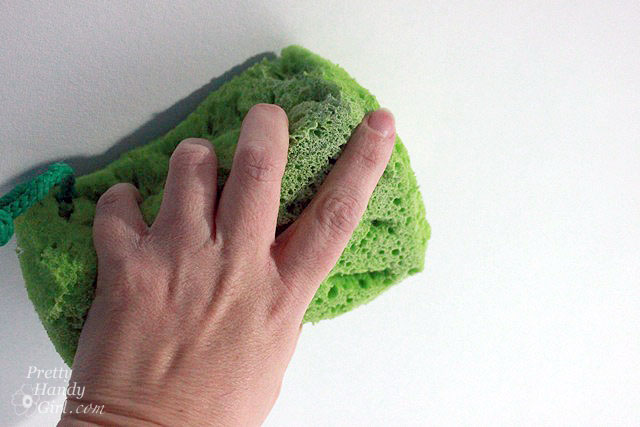
Paint the ceiling with two coats of a flat paint in your color choice. If you want a more thorough tutorial on painting ceilings, read this post.
Personally, I like using an ultra bright flat paint like Valspar. It has the best light reflection ability.
After all your hard work, pat yourself on the back and then carefully roll up the tarps and take out the trash. That will be one heavy bag!
Coming up next week: Installing the FlowWall System and a giveaway! You don’t want to miss it.
 P.s. Thank you for all your prayers and kind words while my son was sick. He is finally feeling better and went back to school yesterday after three weeks. We are fairly certain that he had norovirus and it just sent his system into a tailspin. Thank goodness for hospitals and modern medicine!
P.s. Thank you for all your prayers and kind words while my son was sick. He is finally feeling better and went back to school yesterday after three weeks. We are fairly certain that he had norovirus and it just sent his system into a tailspin. Thank goodness for hospitals and modern medicine!

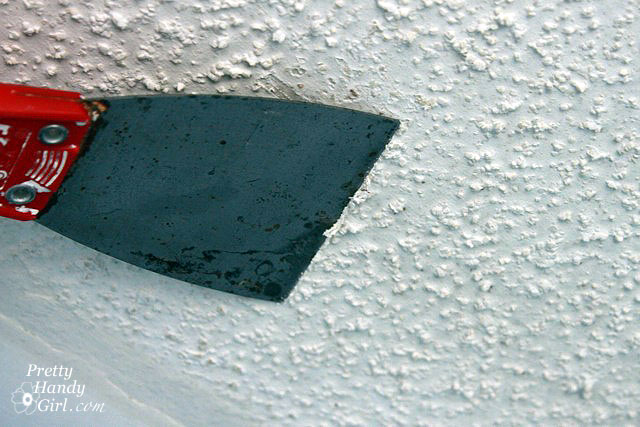
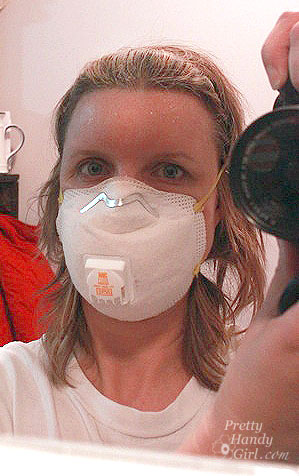
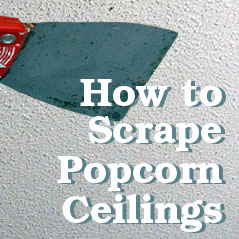
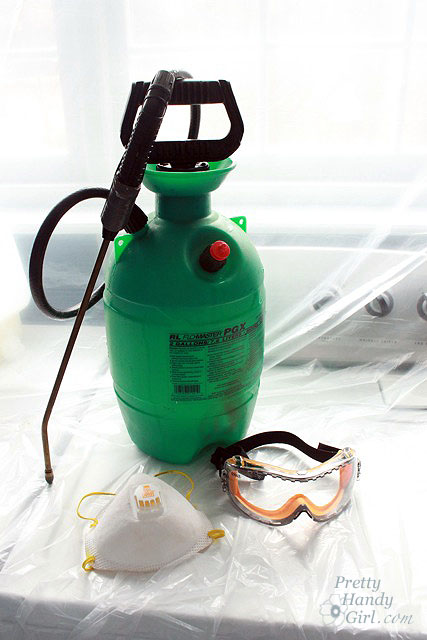

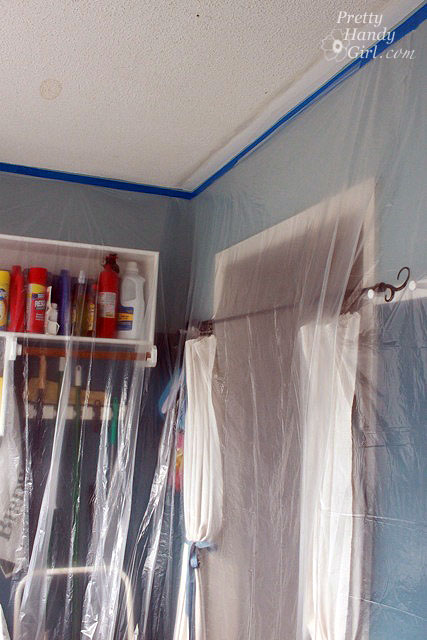

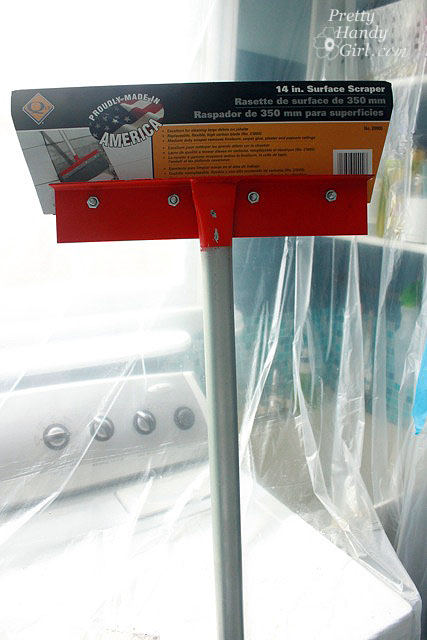
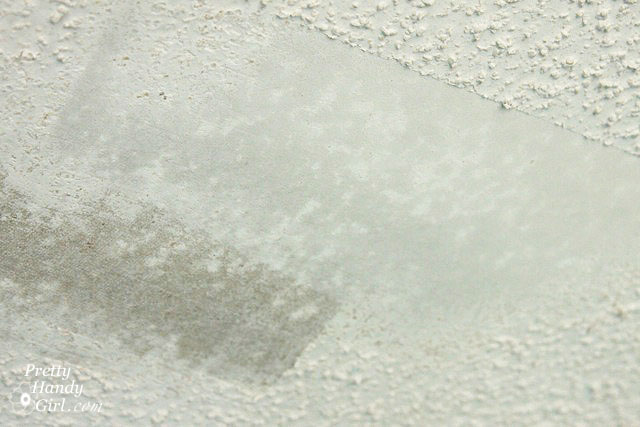
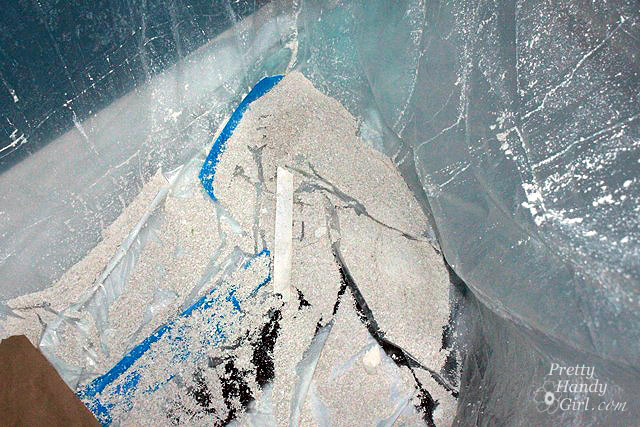
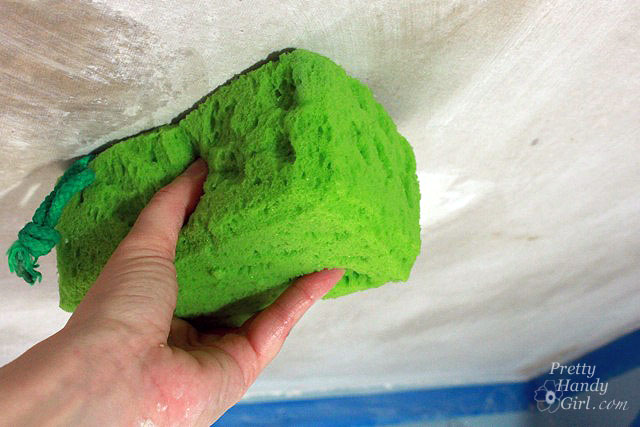
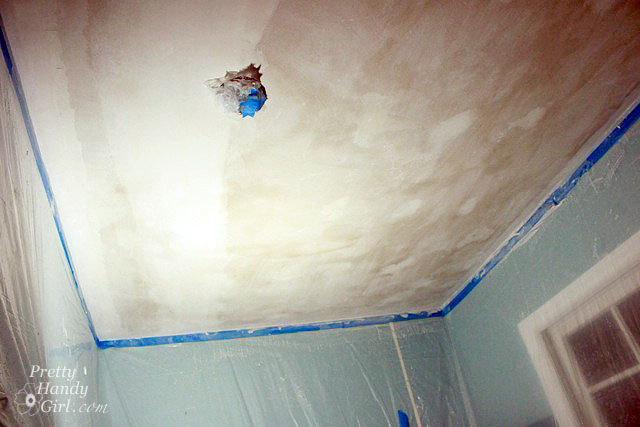

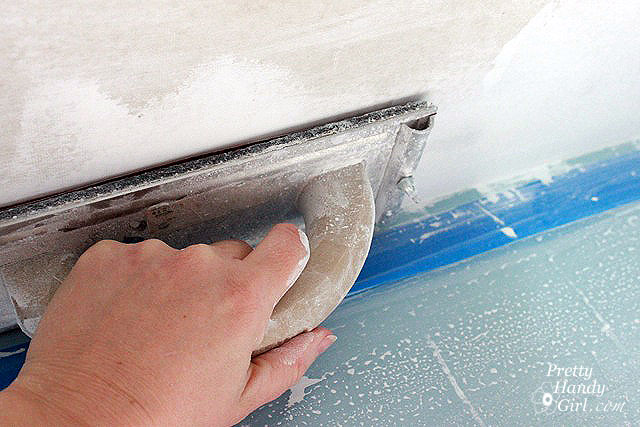
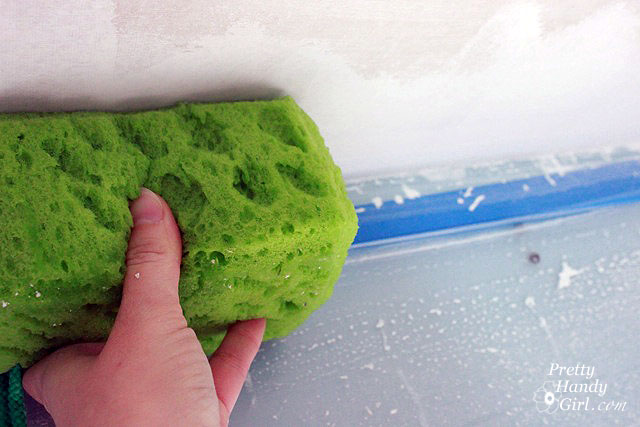
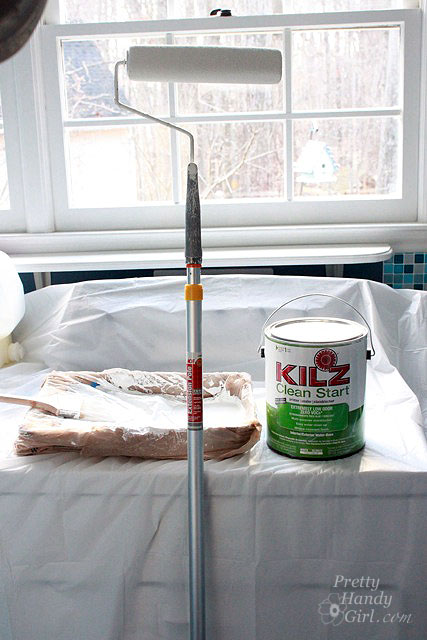

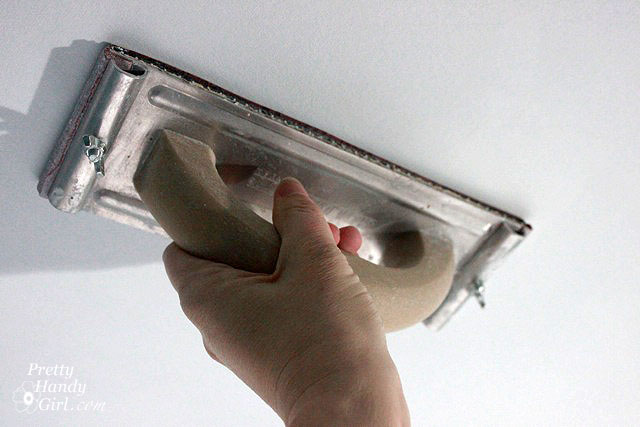
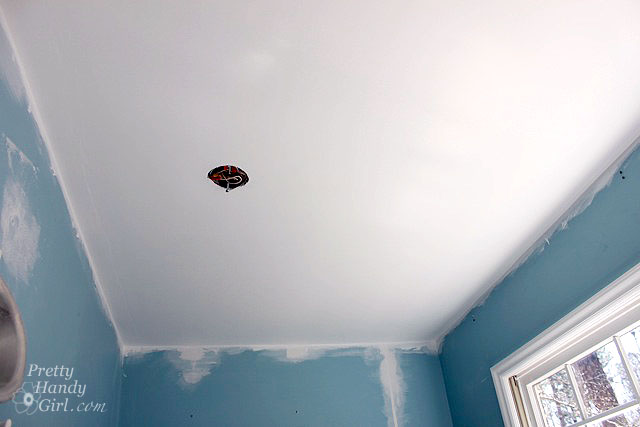

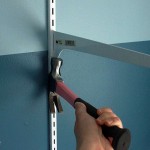
Great information! My brother did our kitchen ceiling and since it had been painted he was up all night scraping, then mudding all the gouges caused by the scraping. Our heating/ac vents are on the ceilings, so you can imagine what that looks like. Oh and we also have a radiant heating system in the ceilings which is probably why they painted since it caused brown streaks (we think that’s what they’re from anyway.) I might try that citrisolv that Karen mentioned and see if that solves the non-dissolving issue. Well, since I’m the one with the bad neck and back it won’t be ME trying it, but someone around here will….
Hi Sharon, I have radiant heating too. Any tips? Can it still be done? I am worried it won’t be as easy and I will have created an even worse eye sore.
thanks for the great info!!!
I will be moving into my childhood home and the living room has popcorn ceiling.. ugh!
I removed the gold-fleck popcorn ceilings in our 1950’s home. One tip that I found helpful is to tie a neck pillow around your neck to reduce the stress.
I am stuck now with small clumps of popcorn coating on the ceiling and some holes. I just haven’t gotten around to finishing the ceilings.
Jeitinho brasileiro: nao retirar o chapisco (popcorn), aplicar sobre o chapisco massa de gesso de estuque e alisar, depois aplicar a massa corrida e depois lixar. No final pintar. Talvez seja menos trabalhoso. Parabens pelo bonito resultado. Congratulations. Vi
Just this month I decided to remove the popcorn from our dining room ceiling. We tried spraying with water. Nothing. Then we heard about adding fabric softener to the water. Nothing. We tried vinegar and water. Nothing. Off to the paint store where the boys were sold an expensive and very caustic product. Nothing. I went to Lowe’s and picked up a bottle of citrisolv stripper. We spread it on, let it sit 30 minutes and the angels sang. It scraped off easily. We did have to apply a skim coat of mud and sand but it is beautiful now. I figure that it must have been painted with oil base paint but was not old enough to have asbestos in it. It was only about 10 years old.
Thanks for that one!! We have a room with painted ceilings.
Brittany, thanks for this tutorial. We have a living room to do and your tips will be very helpful. Like the idea of using the floor scraper.
One question…How many hours did you wait between after the popcorn was removed and the ceiling was cleaned of dust before you began repairing the ceiling?
Thanks!
There really is no need to wait as long as your ceiling isn’t still wet. Mine dried fairly fast. I hope that helps ;-).
I did the whole house because I couldn’t stand popcorn ceilings. I found it helpful to round the edges of the putty knife so it didn’t leave gouges in the ceiling. It is a messy job but looks absolutely beautiful in the end.
Klara, excellent tip! I’ll have to try that next time. Did you use a metal file to round the edges?
Woohoo. Glad to see it gone. I hate popcorn…on ceilings. 😀
You are more than welcome to come visit and help me remove the rest of them ;-D
Had an uncle in the construction business years ago. He said popcorn ceilings were quick, cheap and easy and a way for contractors to save a bit of money.
In this part of the country, “knock down” or “orange peel” finishes are all the rage for walls and ceilings in new houses. We built a new ‘old’ house five years ago and I ‘pissed off’ our plaster contractor because I insisted on smooth walls and ceilings. He didn’t like it because they take so much longer to do. Oh, well…
I think your uncle is right. Cheap and easy. To me it is ugly, dust catching, light trapping, and makes the ceilings feel lower. Only 2 more rooms to do and 2 hallways and a bath!
I have one more room and then I have one room the previous owner decided to swirl the ceiling with texture. I am dreading that one! Good call on the floor scraper. Love your info! Mostly, because it is confirming a lot of what I do! Good to know I am doing a good job…LOL! Thanks!
Hats off to you girl. I bet you are so glad it is done! The finished ceiling looks great too, glad to see it was pretty easy 🙂
Awesome job! Question for you. Do you think that this same method would work for a ceiling that is textured but not popcorned? I have some tape problems on the ceiling in the garage that I’m closing and I know that at the very least I will have to retape it, but I hate working around the texture. I wouldn’t mind the work if I could get it off. Always liked a smooth ceiling anyway.
Lori, thanks for your comment. Hmm, I’m not sure. I guess you could try a test area. It really depends on what was used for the texture. Try asking around to some of the neighbors too. They may have tried it.
It won’t. You are going to have to some how sand it…that is my next project. Good luck!
Great job!! Our living room needs to be done, but I admit the tasks seems daunting due to the size of the room. I probably would have just gone at it dry, so the wetting it down tip was good.
Carole, if you do the living room, definitely look for one of those floor scrapers in the linoleum and tile section of your home improvement store. I found mine at Home Depot.
Good luck! 😉
My husband and I are scraping the ceilings throughout the whole house. We have tried wetting it down and doing it dry, and dry is the way to go. If you wet it down it doesn’t make it any easier to remove and it makes a larger mess.
So glad the little guy is on the mend. Thank goodness.
Now as for popcorn ceilings – who ever thought that they were a good design decision?? It looks great now 🙂
Jane, actually I heard from the builder of our house that joint compound has improved a lot over the years. Before it was easier to texture the ceilings to hide the joints and tape. However, I don’t know if I agree with that “excuse”. It seems that they have been taping and mudding wall seams for years ;-D
Glad to hear your son is doing better! After painting all our oak trim white, the popcorn ceilings are next on my hit list! Thank you so much for this tutorial! I am hoping I can convince the hubby we need to do this. He thinks that you have to retexture the entire ceiling after you scrape it off. This might be my answer to him!
LOL! Uh oh, I think I might be on your hubby’s “hit list” after you show him this. 😉 Thanks for your comment.